Bosque Co., Texas by Elroy Christenson
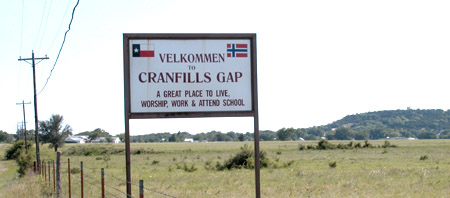
East SH #22 entrance to Cranfills Gap, Texas

East SH #22 entrance to Cranfills Gap, Texas
Cranfills Gap community was named for
George Eaton Cranfill who came to Texas from Illinois. According
to Gail Cranfill Whittingham, his great grand-daughter, he sold
his farm in Illinois in September 1854 when he moved to Dallas
County. By 1856 he was paying taxes on a lot in Lancaster, Texas
where he seems to have remained through 1860.
[George E. Cranfill
entry, Dallas County, Texas; Dallas County Tax Rolls
1846-1910, microcopy reel 155; Texas State Library, Archives
Division, Austin.] He finally bought land
in Bosque County on February 5, 1859. "The land was part of the
original survey made for Francis Renfro who had died with his
father, Creath (Renfro), from an Indian raid in 1857." George's
father-in-law was Erasmus Canter. George's son, Samuel B.
Cranfill, established the Cranfills Gap Post office at Cranfills
Gap, Bosque County, on May 21, 1879 on Meridian Creek on the
Hamilton-Bosque County line in what was an old stage coach stop.
To correct the history, Samuel Cranfill's father-in-law was
William Nelson Crawford as stated in the Deed Book of Coryell
County, Gatesville, Texas. According to Tony Rohne the building
still stands on land owned by Chris Morris Rohne Hanson. A month
later it became Cranfills Gap, Bosque County. The community is
situated in the gap between two small limestone hills that
formed the passage between the cities of Hillsboro, Meridian,
and Hamilton, Texas. It lays on Texas State Highway #22 and Farm
Road #219. Up to the 1960's Cranfills Gap was a vital farming
community supporting the efforts of the dry land farming of
corn, grains, and cotton. More recently many of the farms have
been turned in the ranches for cattle and private hunting
reserves for deer and more exotic animals. [records of Gail Cranfill Whittingham, Sept. 2020]
Prior to the Spanish coming into the region this area had been the hunting grounds for Tonkawa and/or Tawakoni tribe. They were migratory hunters of deer and wild game which inhabited the area primarily around the Brazos river north of Waco. They were said to have numbered about1600 when the Spanish arrived about 1690. Their population was reduced to less than half after a small pox epidemic. The tribe was herded into two missions by the Spanish but they resisted staying in one place for very long especially with other tribes incursions into their area. In 1756 they assisted in the destruction of the San Saba Mission set up for the Apache, which also moved into the area. In 1855 the United States government establish two reservations on the Brazos river for the Tonkawa and several other tribes. By 1859 the white settlers made so many complaints that the were removed to the Oklahoma territory. Here In 1862 the Delaware, Shawnee, and Caddo Indians found an opportunity to settle old scores and massacred 137 of the 300 remaining Tonkawa tribe. When finally protected and gathered into one reservation in 1884 near Ponca, Oklahoma they numbered only 92; by 1937 the population was only 51. [Texas Tribes]
The Spanish colonization of Texas began as
early as 1716 although it did not really become efficient at
giving and surveying the land grants to individuals until 1767.
Some of the original grants were given on the basis of merit or
seniority. The largest of these "porciones" consisted of 600,000
acres. [Texas Red River Authority] It is said that the rock
fence that runs to the north and west of Cranfills Gap was built
by some of these Spanish settlers with the assistance of Indian
volunteers or (probably) Indian slaves. This rock fence which
runs for miles across the hilly landscape was used as a
demarkation of the property but also to keep control of grazing
stock. It has fallen in the disrepair more recently with some
parts of it being used as a quarry for building material by the
locals. I have not been able to ascertain the length or
direction of the entire fence that still exists but it also
passes near the old stage coach stop and was one border of Pete
Christenson's farm in Hamilton County. Many farmers used
the stone from the fences in buildings for their farms so it may
only exist is certain locations.
Eventually the Spanish offered land grants
as enticements to new settlers from the United States and other
foreigners. Under the Republic of Texas rule "first class"
head-right grants were given to all heads of families living in
Texas on March 4, 1836 except Africans and Indians consisting of
one league and one labor (4605.5 acres) and single men who were
seventeen years or older would get one-third of a league
(1,476.1 acres). By 1841 "fourth class" land grants were given
to heads of families of 640 acres and 320 acres to single
individuals. [Texas Red River Authority]
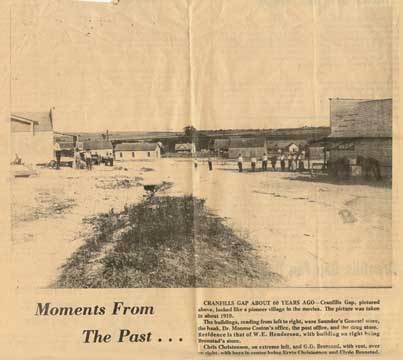
Cranfills Gap, 1910
unknown photographer, reprinted in the Clifton Record,
1978
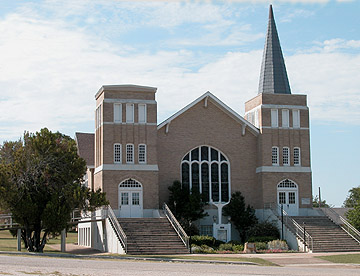
The First Norwegian families started coming
to this area of Texas as early as 1841.  The State of
Texas offered major land incentives for settlers of Norway, Sweden,
and Denmark. They were led here largely by Cleng Peerson who
helped Norwegian settlements across the United States. The Rock Church was built
about 1888 by Andrew Mickelson with local help. See more information here on the
Rock Church and the Scandinavian Community. The vitality of
this heritage is still celebrated with a "lutefisk dinner" each
year that draws crowds from all over Texas.
The State of
Texas offered major land incentives for settlers of Norway, Sweden,
and Denmark. They were led here largely by Cleng Peerson who
helped Norwegian settlements across the United States. The Rock Church was built
about 1888 by Andrew Mickelson with local help. See more information here on the
Rock Church and the Scandinavian Community. The vitality of
this heritage is still celebrated with a "lutefisk dinner" each
year that draws crowds from all over Texas.
During the 1930's and 1940's many residents started the gradual emigration to other regions because of both the Depression and World War II. My grandfather, Pete Christenson, almost lost the farm during the Depression and only survived by selling off a large portion to make the necessary payments. My own parents and several relatives moved to Gary, Indiana to work in the steel mills during the war. The population of the town has varied from about 500 to the present 329 people.
During the 1960's Bynus (Binus?) Tindell
ran an old fashioned drugstore on the corner 3rd Street, which
was the main shopping street. It was a full service drugstore
with a marble counter-topped soda fountain with wire framed
chairs and marble-topped tables. Cherry Cokes were the
specialty. Comic books were available for discounted prices
because the covers had been taken off. Behind the drugstore was
the local doctor's office and next door on the north was The
Viking Theater (later the Gap Theater), owned by a Mr. Millinax,
which still stands but has not operated for 20 years. My dad was
a projectionist during the 1930's for a period of time while my
mother worked in the ticket booth.
Next to the Viking picture show was a two story
limestone buildings until the 1940's that contained a shoe shop that my father
operated for a while with the major part of the
building used for a dry-goods store. It had been the
tallest building in the community. The building was
torn down and replaced with the smaller of two grocery
stores in the town. At one time there were as many as
five grocery stores. This store was a co-op grocery
store. It contained local vegetables and necessary
household items where folks sold and bought bulk
quantities of sugar and bread flour in 50 pound cotton
print bags. These bags could be later turned into
dresses or used as fabric for patchwork quilts that
were created by the Women's Axillary (Ladies Aid)
group of St. Olaf's church. My grandmother, Eva
Christenson, sold them regular quantities of eggs and
butter.
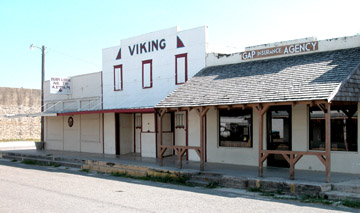
The old drug store, Viking
Cinema and grocery store south toward SH #22.
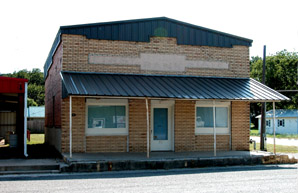
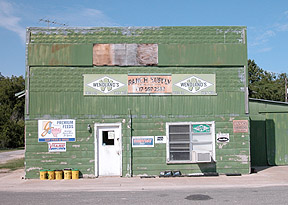
The old First Security State Bank
The Feed Store
(now
called
the
Horny
Toad
Bar
and Grill)
Just down the street on the same side was the First Security State Bank whose president was Chris Rohne, my father's cousin. It was first chartered in 1910 as the First Guaranty State Bank of Cranfills Gap. It has since built a new building across the street. Across the street on the same side of 3rd Street used to be a garage owned by my grandfather, Ed Johnson, my uncle Herman Reesing and my dad. Here they worked on combines, thrashing machines, and steam engines. Since it was a big building it was rented out during the 1930's to show silent films complete with live piano music on a regular basis. This was before the cinema was built. Occasionally it was also rented to a medicine show. The feed mill across the street from the bank had all the expected items. South of the feed store on the next block was Witte's Hardware store and the larger grocery store and combination gas station. This corner store in the 1920's had been a gas station for early autos with a blacksmith shop which my grandfather, Pete Christenson, owned was in the rear for the continued use of horses . Besides shoeing horses he also had a couple of thrashing machines that he rented and operated during the wheat and oats harvest seasons. Across the Highway 22 from the grocery is a garage in which local cars, trucks and tractors were repaired. Another limestone faced gas station existed on the other corner of the main intersection. This also became a domino parlor at one time. Somewhere in town I remember there being a barbershop. The barber, Bernt Bertelson, at that time was about 70 years old and had dyed black hair that looked very peculiar to me as a child. It seemed to be another center of local gossip for the men of the community.
Entertainment came in various forms. In the
location of the new bank was a building that was a domino parlor
which had various locations in town. Here the local men folk
played games during the heat of the day but in the evenings they
would play croquet in vacant lots. Next to the present Post
Office, which had been the Bronstad Store, was an empty lot that
had been turned into a professional croquet court with concrete
perimeters and 1/2" steel wickets. In another empty lot on the
opposite side of the street behind the hardware store was
another similarly laid out court for the competition.
This one had lights making it possible to play all night.
The games were very heated and probably were used to lay small
wagers. The courts no longer exit and the lots have returned to
the earlier weed patches they were. Vacant lots were used also
for religious revival meetings and itinerant roller rinks under
tents. Occasionally someone would invite several families over
to there house for "A Singing". Folks would gather around a
piano and sing songs such as hymns and other old standards. The
community also had a concert band. Several of my relatives were
members including Jake Christenson, Mangus Rohne, Bernhardt
Rohne, and Freddie Bertelson.
A couple of block west at the intersection with FR 219 was location of the Cranfills Gap Cotton Gin operated by A. C. Grimland. It was a co-op gin for the local farmers. Here they brought the cotton by horse or tractor from local fields. The building has long since been torn down and presently houses a wrecking yard of antique tractors. Just south of the gin was the switch board for the local phone company. The Cranfills Gap Phone Company set up in 1906 was the most antique hand-crank magneto type with five to ten families hooked to a single line. Each family had a separate ring such as one long and two short rings and everyone on the party-line knew exactly what was going on in every family. Dating was quite an experience since everyone frequently listened in on the conversations. In 1971 it was sold to the Clifton Telephone Company which updated the equipment to rotary dial phones.
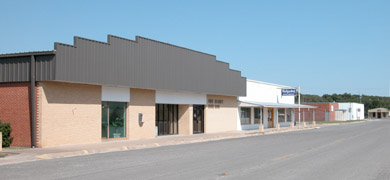
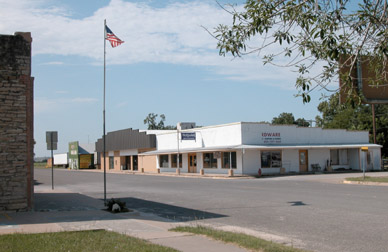
The school holds all grades in two buildings and sit on a hillside on the other side of the creek that runs through the community. The community was one of several in Texas that were identified as a losing population by the Dallas Morning News in 1999. Along with population it has also lost a very vital way of life. Many of the present residents are retired or commuting long distances for work. Farming in the area has changed with the consolidation of land holdings. Where there were 15 to 20 family farms north of the Gap now there is one large ranch. These are usually owned by folks who live in the Dallas/Fort Worth area and have little to do with the local community. Some of the farms have been turned into hunter sanctuaries for trophy deer and elk. One such farm near the Rock Church has high wire fences and security cameras monitoring the perimeters.
National notoriety for the town came in a November, 1970 visit by Charles Kuralt, the Columbia Broadcasting System television commentator, for his series The Man on the Go. They filmed the District Championship Football game between Iredell community high school and the Gap. Since these are small districts they came up with a unique form of football based on a Six-man football team.
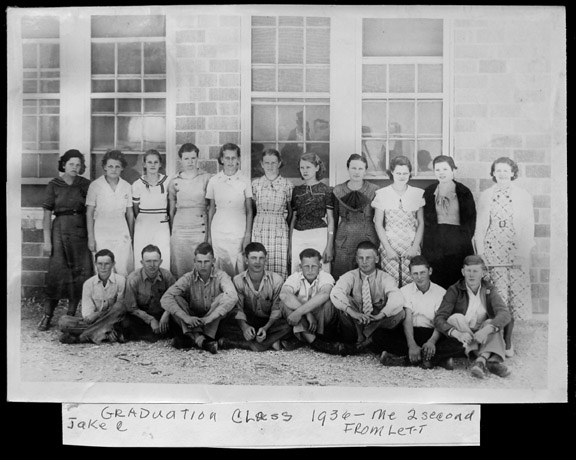
sources:
Johnson/Rohne/Christenson
photo map
Egeberg/Johnson lineage map
|| Johnson Family Index
Elroy's Family Index || Ancestor Chart #1 || Regional History Index






All information and
photos included within these pages was developed by
the help of hundreds of researchers. The information
here is for the express purpose of personal
genealogical research and is freely offered as long as
this site is listed as a source. It may not be
included or used for any commercial purpose or
included in any commercial site without the express
permission of Elroy Christenson. Copyright Elroy
Christenson 1998-2020.